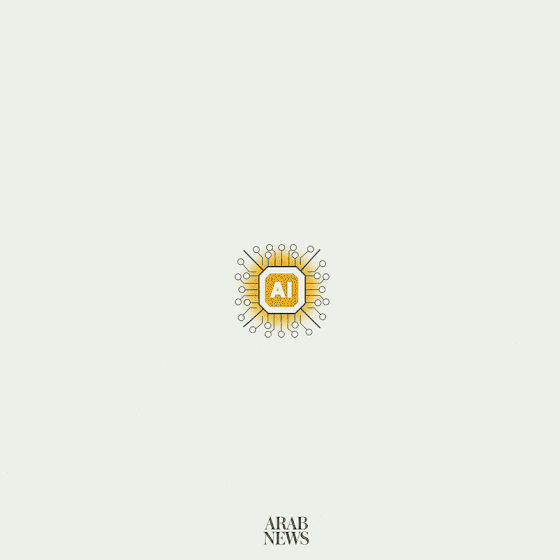
- ARAB NEWS
- 01 Jul 2025

Although our age is defined by humanity’s disproportionate influence on the planet, we ourselves are undergoing profound changes. Tasks that could previously only be accomplished through human labor are increasingly being performed by machines, including many tasks that rely on creativity. Far from a distant theoretical possibility, artificial intelligence has arrived — and it is here to stay.
In considering AI’s potential, it can be tempting to channel the techno-optimism of the 1990s, when IBM’s Deep Blue triumphed over the world chess champion Garry Kasparov, unleashing a wave of interdisciplinary interest in how AI might be deployed and commercialized in other domains. But it can also be tempting to adopt the opposing view and insist that AI will become an intolerable threat to most people’s livelihoods and perhaps even to human existence itself.
Both reactions are not new: They have often accompanied the emergence of major innovations. They also make similar mistakes, because both treat technological progress as if it were something separate from us. Nowadays, the optimists fixate on what AI might do for us, while the pessimists worry about what it will do to us. But the question we should be asking is: what will AI do with us?
This question is as pertinent to fine art as it is to finance, despite the apparent differences between these domains of quintessentially human activity. New media art is best understood as a dialogue between experimentation and tradition. The human longing for novelty and tradition are mutually dependent: Only by appreciating what came before an artwork can we comprehend what makes it new. No work is fully independent of cultural heritage, just as light cannot be understood in the absence of darkness.
Investing, too, is a hybrid enterprise. Success lies in recognizing genuine forms of innovation, which in turn requires an appreciation of what has already been done.
This interplay between past and present also describes generative AI itself. By drawing on vast stores of previous human expression — data — AI can achieve near-universal applicability and facilitate innovation across many areas of culture and industry.
It was this understanding of AI that led us to pursue our collaborative project, which is known as Dvorak Dreams. By harnessing the power of machine learning, we transformed the 19th-century Czech composer Antonin Dvorak’s compositions, visual archives and legacy into a 100-square-meter installation that was exhibited throughout the annual Dvorak Prague Festival in September in front of the UNESCO-listed Rudolfinum. As the inaugural project of the 0xCollection, a new cultural initiative dedicated to digital art, the piece exemplified AI’s potential as a tool for both transforming human creativity and enriching cultural heritage.
AI is admittedly extraordinarily powerful, but it is hardly the first technology to alter the human condition.
Refik Anadol and Karel Komarek
Artists working with AI can map out a path for the technology’s role across society more broadly. Today’s algorithmic models rely on massive quantities of training data, most of it created by and for human consumption, and this makes them immensely powerful tools for pursuits like research and development. From hundreds of hours of classical music to more quantitative types of data, it is human input that makes AI’s output meaningful and intelligible. Only by maintaining this symbiotic connection between us and our rapidly evolving technologies can we ensure that AI’s development brings more benefit than harm.
Make no mistake: The benefits of machine learning could be profound. As novel and alien as it may seem to us now, AI is uniquely capable of serving human ends — from optimizing technological efficiency to aiding in the creation of artwork that can be appreciated by audiences around the world. The human response to AI’s output is what will determine its utility, including as an instrument of meaning-making. There is no denying that AI will play an expanding role in our increasingly digitalized world. What we need is a strategy of coexistence that respects, elevates and optimizes both human and machine.
To that end, we see Dvorak Dreams as a proof of concept. Rooted firmly in human sources and imaginative expressions, it leveraged AI to retrieve, synthesize and extend the legacy of an earlier cultural pioneer. The resulting presentation was not simply a machine-generated “hallucination;” it was a display of co-evolution. An “artificial” intelligence, guided by human intervention, made a past cultural production real to us in the present. It both revived history and created it anew. Finding value lies in uniting tradition with novelty. Without both elements, the final product would not move us.
Dvorak Dreams required us to put aside debates about humans versus humans and humans versus machines. The result was beneficial both for the development of technology and for the progress of contemporary art. Now, we find ourselves calling for a revolution — not of the technology, but of humanity’s attitude toward it. AI is admittedly extraordinarily powerful, but it is hardly the first technology to alter the human condition.
We need not assume the position of either a true believer or an unbending critic. Human progress emerges from collaboration between us and, beyond that, between us and our machines. In this sense, the role of artists, investors and innovators in the AI revolution is the same: to combine openness toward the future with informed appreciation of the past.